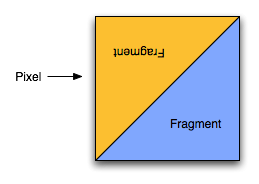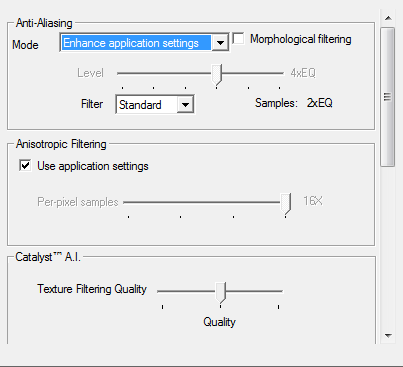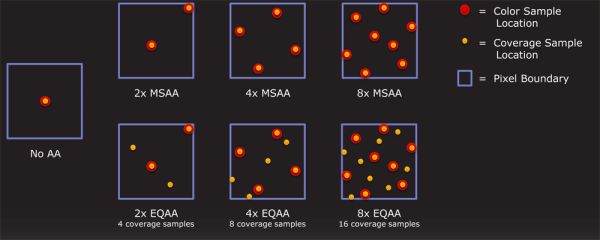AMD's Radeon HD 6970 & Radeon HD 6950: Paving The Future For AMD
by Ryan Smith on December 15, 2010 12:01 AM ESTAnother New Anti-Aliasing Mode: Enhanced Quality AA
With the 6800 series AMD introduced Morphological Anti-Aliasing (MLAA), a low-complexity post-processing anti-aliasing filter. As a post-processing filter it worked with a wide variety of games and APIs, and in most cases the performance overhead was not very severe. However it’s not the only new anti-aliasing mode that AMD has been working on.
New with the 6900 series is a mode AMD is calling Enhanced Quality Anti-Aliasing. If you recall NVIDIA’s Coverage Sample Anti-Aliasing (CSAA) introduced with the GeForce 8800GTX, then all of this should sound quite familiar – in fact it’s basically the same thing.
Under traditional MSAA, for a pixel covered by 2 or more triangles/fragments, 2, 4, or 8 subpixel samples are taken to determine what the final pixel should be. In the process the color of the triangle and the Z/depth of the triangle are both sampled and stored, and at the end of the process the results are blended together to determine the final pixel value. This process works well for resolving aliasing along polygon edges at a fraction of the cost of true super sampling, but it’s still expensive. Collecting and storing the Z and color values requires extra memory to store the values and extra memory bandwidth to work with the values. Ultimately while we need enough samples to determine colors of the involved triangles, we do not always need a great deal of them. With a few color/Z samples we have all of the color data we need in most cases, however the “hard” part of anti-aliasing becomes what the proper blending of color values should be.

1 Pixel Covred by 2 Triangles/Fragments
Thus we have EQAA, a compromise on the idea. Color/Z samples are expensive, but just checking if a triangle covers part of a subpixel is very cheap. If we have enough color/Z samples to get the necessary color information, then just doing additional simple subpixel coverage checks would allow us better determine what percentage of a pixel is covered by a given polygon, which we can then use to blend colors in a more accurate fashion. For example with 4x MSAA we can only determine if a pixel is 0/25/50/75/100 percent covered by a triangle, but with 4x EQAA where we take 4 color samples and then 4 additional coverage-only samples, we can determine blending values down to 0/12/25/37/50/62/75/87/100 percent coverage, the same amount of accuracy as using 8x MSAA. Thus in the right situation we can have quality similar to 8x MSAA for only a little over 4x MSAA’s cost.
In reality of course this doesn’t always work out as well. The best case scenario is that the additional coverage samples are almost as good as having additional color/Z samples, while the worst case scenario is that additional coverage samples are practically worthless. This depends on a game-by-game, if not pixel-by-pixel basis. In practice additional coverage samples are a way to slightly improve MSAA quality for a very, very low cost.
While NVIDIA has had the ability to take separate coverage samples since G80, AMD has not had this ability until now. With the 6900 hardware their ROPs finally gain this ability.
Beyond that, AMD and NVIDIA’s implementations are nearly identical except for the naming convention. Both can take a number of coverage samples independent of the color/Z samples based on the setting used; the only notable difference we’re aware of is that like AMD’s other AA modes, their EQAA mode can be programmed to use a custom sample pattern.
As is the case with NVIDIA’s CSAA, AMD’s EQAA mode is available to DirectX applications or can be forced through the drivers. DirectX applications can set it through the Multisample Quality attribute, which is usually abstracted to list the vendor’s name for the mode in a game’s UI. Otherwise it can be forced via the Catalyst Control Center, either by forcing an AA mode, or as is the case with NVIDIA, enhancing the AA mode by letting the game set the AA mode while the driver overrides the game and specifies different Multisample Quality attribute. Thus the “enhance application settings” AA mode is new to AMD with the 6900 series.

To be honest we’re a bit ruffled by the naming choice. True, NVIDIA did go and have to pick daft names for their CSAA modes (when is 8x not 8 sample MSAA?), but ultimately CSAA and EQAA are virtually identical. NVIDIA has a 4 year lead on AMD here, and we’d just as well use NVIDIA’s naming conventions for consistency. Instead we have the following.
| Coverage Sampling Modes: CSAA vs EQAA | ||||
| NVIDIA |
Mode (Color + Coverage) |
AMD | ||
| 2x | 2+0 | 2x | ||
| N/A | 2+2 | 2xEQ | ||
| 4x | 4+0 | 4x | ||
| 8x | 4+4 | 4xEQ | ||
| 16x | 4+12 | N/A | ||
| 8xQ | 8+0 | 8x | ||
| 16xQ | 8+8 | 8xEQ | ||
| 32x | 8+24 | N/A | ||
AMD ends up having 1 mode NVIDIA doesn’t, 2xEQ, which is 2x MSAA + 2x cover samples; meanwhile NVIDIA has 16x (4x MSAA + 12 cover samples) and 32x (8x MSAA + 24 cover samples). Finally, as we’ll see, just as is the case for NVIDIA additional coverage samples are equally cheap for AMD.











168 Comments
View All Comments
henrikfm - Wednesday, December 15, 2010 - link
The right numbers for these cards considering the performance:6970 -> 5875
6950 -> 5855
flyck - Wednesday, December 15, 2010 - link
Anand also tested with 'outdated' drivers. It is ofcourse AMD fault to not supply the best drivers available at launch though. But anand used 10.10, Reviews that use 10.11 like HardOcp see that the 6950 performance equally or better than 570GTx!! and 6970 trades blows with 580GTX but is overall little slower (but faster than 570GTX).And now we have to wait for the 10.12 drivers which were meant to be for 69xx series.
flyck - Wednesday, December 15, 2010 - link
my bad anand tested with 10.11 :shame:10.12 don't seam to improve performance.
That said, Anand would it be possible to change your graphs?
Starting with the low quality and ending with the high quality? And also make the high quality chart for single cards only. Now it just isn't readable with SLI and crossfire numbers through it.
According to your results 6970 is > 570 and 6950~570 but only when everything turned on.. but one cannot deduct that with the current presentation.
Will Robinson - Wednesday, December 15, 2010 - link
$740 for HD6970 CrossfireX dominates GTX580 SLI costing over $1000.That's some serious ownage right there.
Good pricing on these new cards and solid numbers for power/heat and noise.
Seems like a good new series of cards from AMD.
prdola0 - Wednesday, December 15, 2010 - link
No, you're wrong. Re-read the graphs. GTX580 SLI wins most of the time.softdrinkviking - Wednesday, December 15, 2010 - link
By a small average amount, and for ~$250 extra.Once you get to that level, you're not really hurting for performance anyway, so for people who really just want to play games and aren't interested in having the "fastest card" just to have it, the 6970 is the best value.
Nfarce - Wednesday, December 15, 2010 - link
True. However AMD has just about always been about value over an all out direct card horsepower war with Nvidia. Some people are willing to spend for bragging rights.But I'm a little suspect on AT's figures with these cards. Two other tech sites (Toms Hardware and Guru3D) show the GTX 570 and 580 solidly beating the 6950 and 6970 respectively in the same games with similar PC builds.
IceDread - Friday, December 17, 2010 - link
You are wrong. HD 5970 in crossfire wins over gtx 580 sli. But anandtech did not test that.ypsylon - Wednesday, December 15, 2010 - link
A lot of people were anxious to see what AMD will bring to the market with 6950/6970. And once again not much. Some minor advantages (like 5FPS in handul of games) is nothing worth writing or screaming about. For now GTX580 is more expensive, but now with AMD unveiling new cards nVidia will get really serious about the price. That $500 price point won't live for long. I expecting at least 50$ off that in the next 4-6 weeks.GTX580 is best option today for someone who is interested in new VGA, if you do own right now 5850/5870/5970 (CF or not) don't even bother with 69[whatever].
duploxxx - Wednesday, December 15, 2010 - link
at that price point a 580 the best buy, get lost. The 580 is way over prized for the small performance increase it has above 570-6970 not to mentioning the additional power consumption. Don't see any reason at all to buy that card.Indeed no need to upgrade from a 58xx series but neither would be to move to a nv based card.